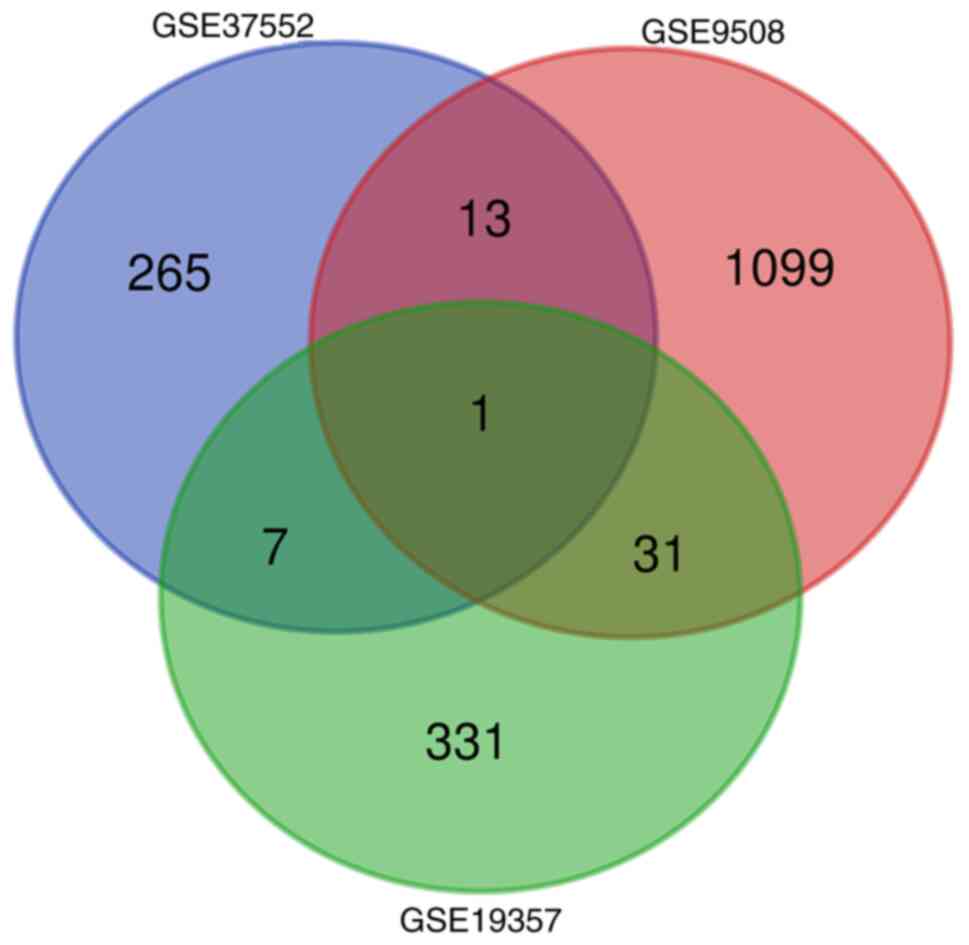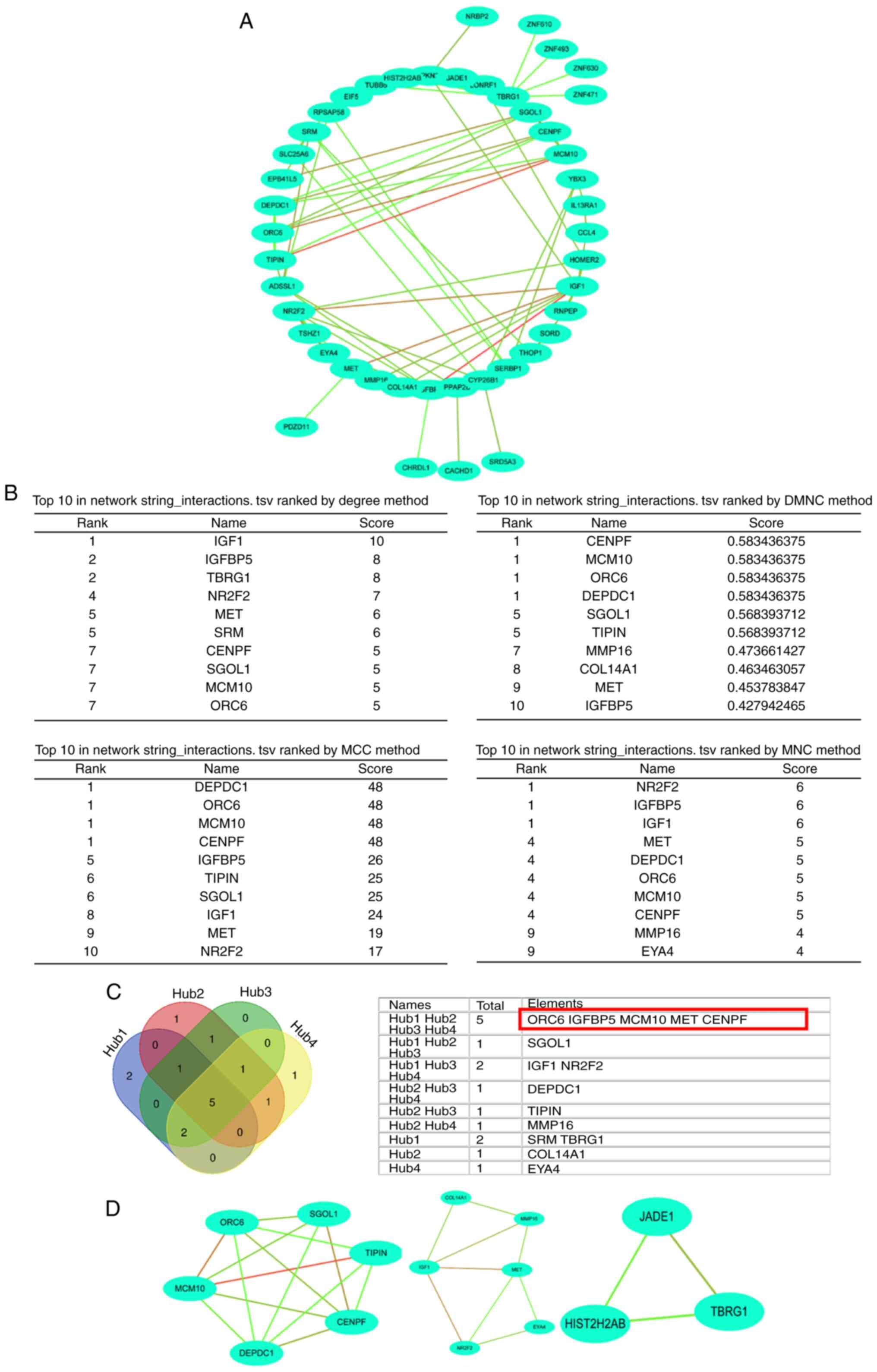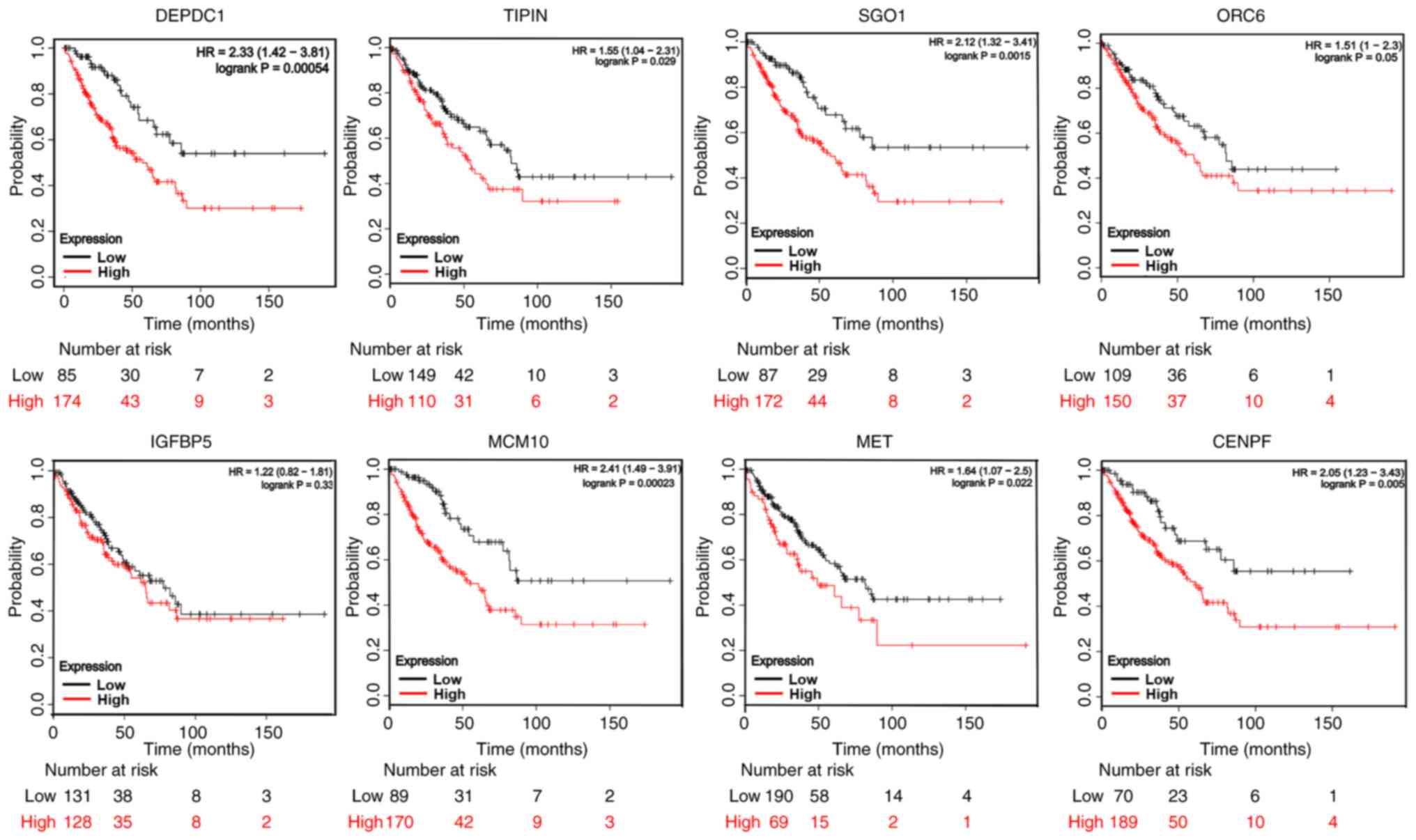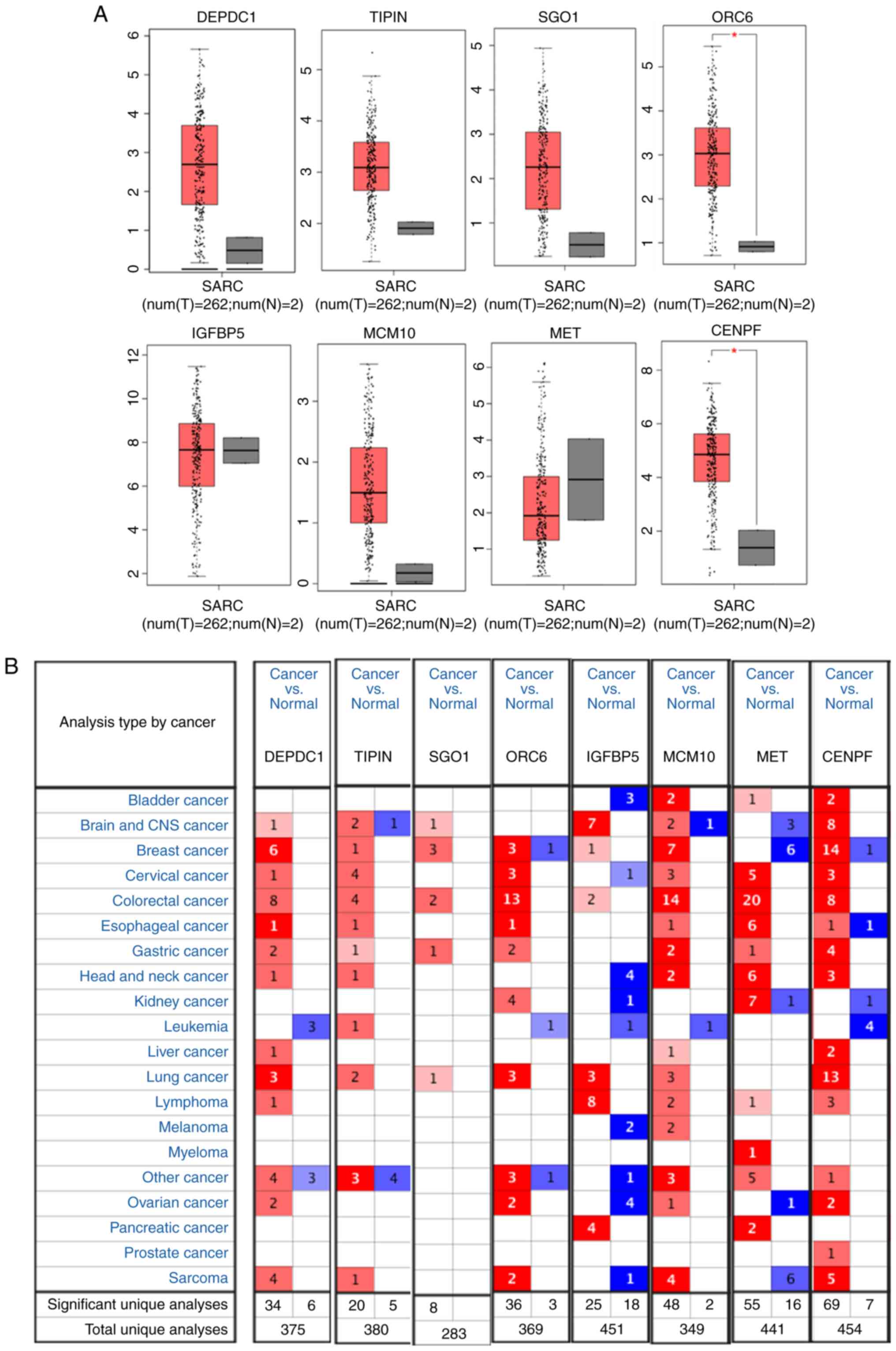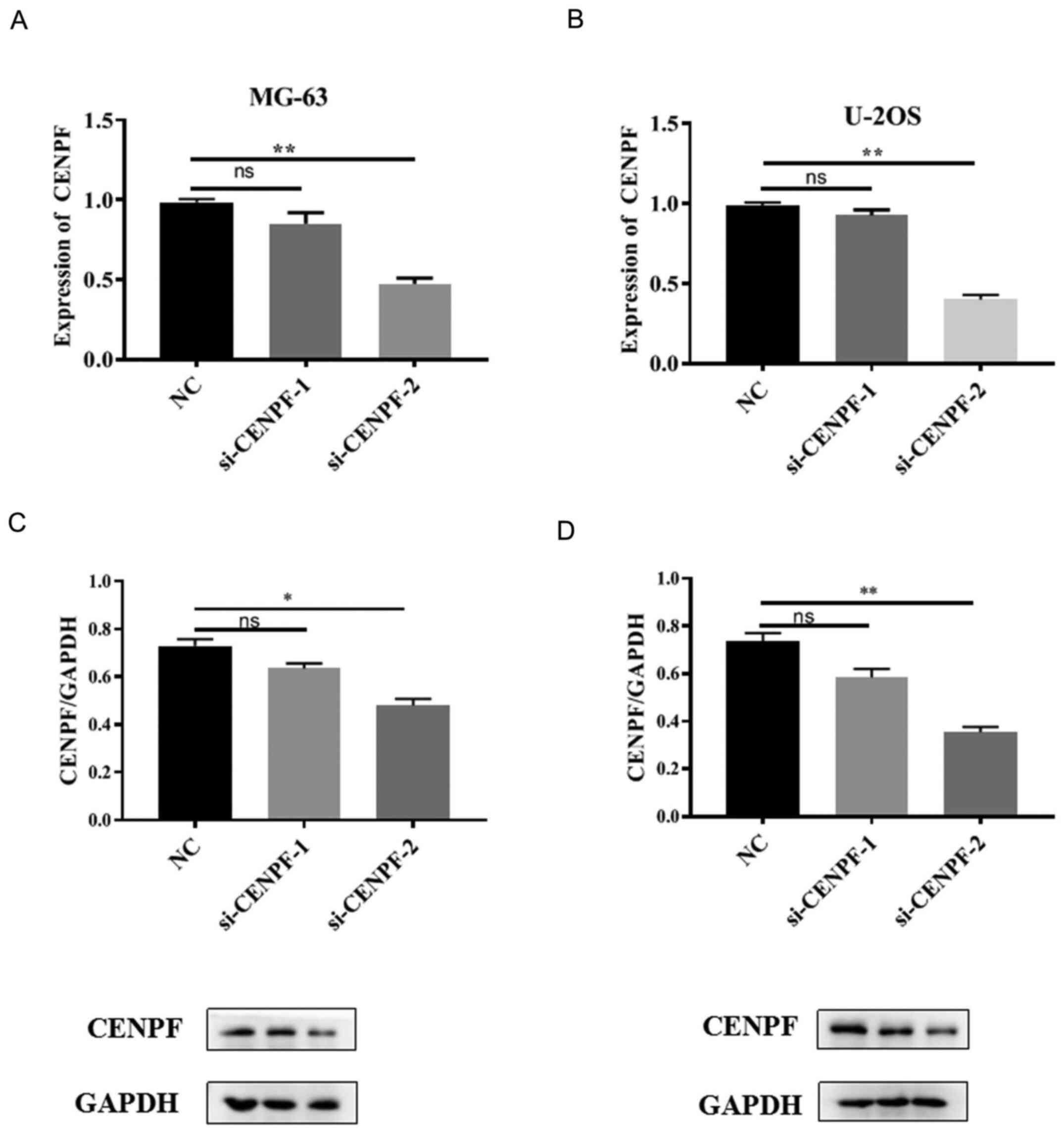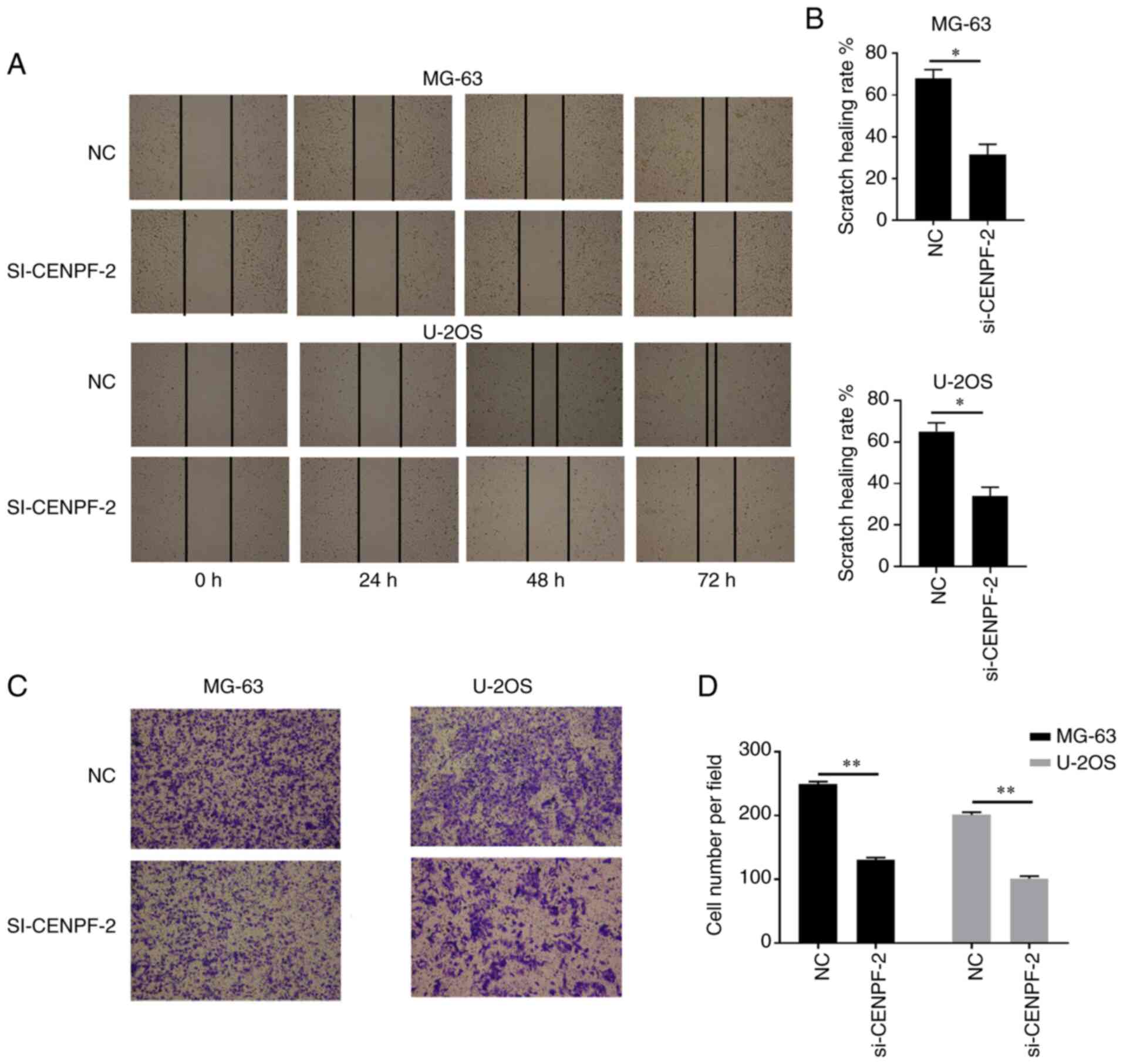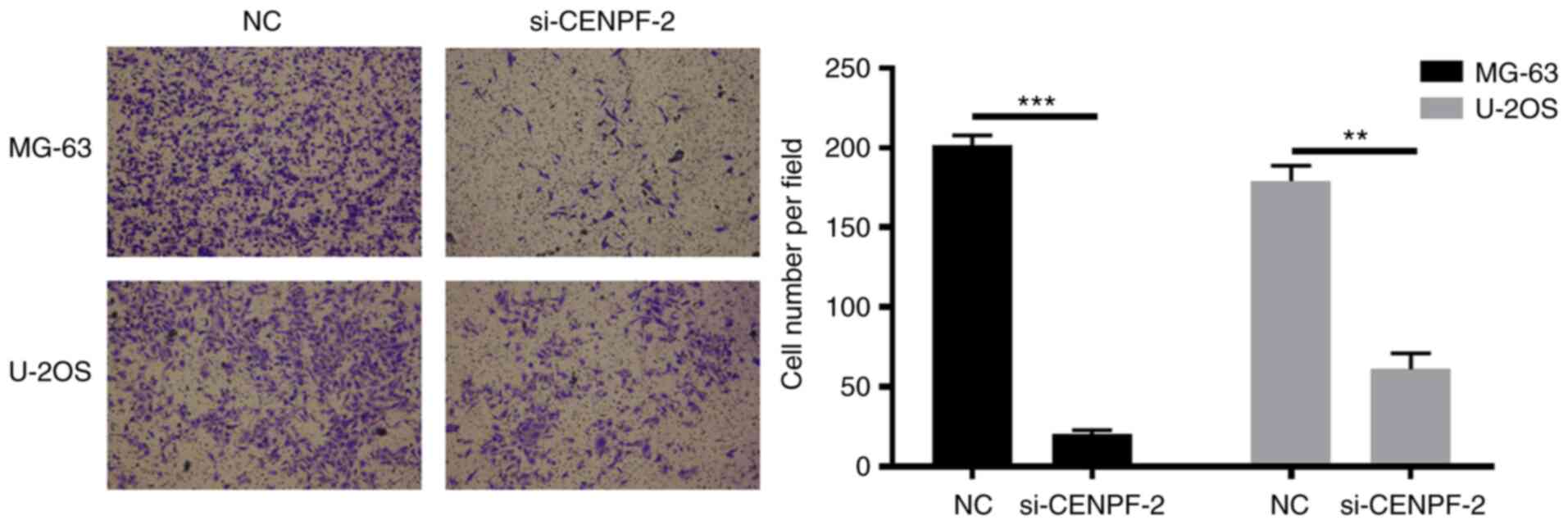Identification of potential key genes and functional role of CENPF in osteosarcoma using bioinformatics and experimental analysis
- Authors:
- Published online on: November 25, 2021 https://doi.org/10.3892/etm.2021.11003
- Article Number: 80
-
Copyright: © Ma et al. This is an open access article distributed under the terms of Creative Commons Attribution License.
Abstract
Introduction
Osteosarcoma is the most common tumor of bone and derives from primitive bone-forming mesenchymal cells (1,2). Patients with advanced osteosarcoma fail to respond to conventional treatments, such as surgical resection, chemoradiation followed by neoadjuvant chemotherapy and local radiotherapy (3,4). Therefore, the prognosis for the majority of patients with osteosarcoma is poor (5,6). Notably, researchers have discovered certain molecular targets associated with osteosarcoma (7-12). Further promising tumor molecular targets remain to be investigated.
Gene Expression Omnibus (GEO) (13) is a public functional genomics data repository of high throughout gene expression data, chips and microarrays. Microarray and bioinformatics analyses have been widely used to screen genetic alterations in various types of tumor, such as breast cancer and follicular lymphoma (14-16). In addition, gene expression level signatures and biological processes are identified using microarray and bioinformatics analyses (17,18). Moreover, promising targets for tumors have also been distinguished. For example, researchers identified the role of microRNA (miR)-101-3p and its functional role in hepatocellular carcinoma using bioinformatics (19); Zhou et al (20) screened 15 hub genes and pathways to identify potential prognostic markers for hepatocellular carcinoma treatment using bioinformatics analysis (20). Integrative bioinformatics have identified links between HNF1 homeobox B with clear cell carcinoma and tumor-associated thrombosis (21), and long non-coding RNA HOXA11-antisense RNA has been demonstrated to have clinical relevance and effects in non-small cell lung cancer (22).
In the present study, bioinformatics analyses were performed to elucidate new targets to provide novel therapeutic targets for the treatment of osteosarcoma In order to select differentially expressed genes (DEGs) in osteosarcoma tissue, gene expression level profiling data was downloaded from the Gene Expression Omnibus (GEO) database. Secondly, Gene Ontology (GO) functional annotation analysis and Kyoto Encyclopedia of Genes and Genomes (KEGG) pathway enrichment analysis were performed for the screened DEGs. Subsequently, a protein-protein interaction (PPI) network was established and Cytoscape software was applied to select hub genes associated with osteosarcoma. Survival analysis of these hub genes was performed using the online database Kaplan-Meier plotter. Oncomine and Gene Expression Profiling Interactive Analysis (GEPIA) databases were used to further confirm the expression levels of hub genes. Notably, a series of functional experiments indicated that knockdown of the core gene centromere protein F (CENPF) suppressed proliferation, migration and invasion in osteosarcoma cell lines.
Materials and methods
Microarray data
Using the GEO database (ncbi.nlm.nih.gov/geo/), three gene expression level profiles [GSE37552(23), GSE9508(24) and GSE19357] were selected based on the platforms GPL570 [(HG-U133_Plus_2) Affymetrix Human Genome U133 Plus 2.0 Array], GPL6076 (Agilent-Whole Human Genome Oligo Microarray G4112A condensed) and GPL6244 (HuGene-1_0-st) Affymetrix Human Gene 1.0 ST Array [transcript (gene) version], respectively.
DEGs profiles
Using the GEO2R (25) online analysis tool (ncbi.nlm.nih.gov/geo/geo2r/), DEGs were identified between osteosarcoma and normal tissue. The DEGs were calculated with thresholds of P<0.05 and |log fold-change (FC)|>1.00. Intersections between each dataset were obtained using the Venn diagram tool (bioinformatics.psb.ugent.be/webtools/Venn/).
Functional and pathway enrichment analysis
GO (26) annotations were downloaded from GO. KEGG (27) pathway enrichment analysis of DEGs was applied to determine enriched signaling pathways. Metascape tool (metascape.org/gp/index.html) was used for annotation. P<0.01 and gene count >3 were considered to indicate a statistically significant result.
Hub genes selection
A PPI network was constructed using STRING (V11.5, Swiss) database (https:string-db.org/). Visualization of PPI networks was performed using Cytoscape software (V3.7.2, BioStar team; https://apps.cytoscape.org/apps/mcode). Hub genes from DEGs were further defined according to module connectivity in the PPI network. Highly interconnected nodes indicated greater essential connectivity. CytoHubba (28) add-on to the aforementioned Cytoscape was used to determine the connectivity of each node measured by degree, density of maximum neighborhood component (DMNC), maximal clique centrality (MCC) and mononuclear cell counts (MNC).
Molecular Complex Detection (MCODE) analysis
A Cytoscape plugin, MCODE (29), was used to identify significant molecular complexes in the PPI network. Corresponding networks of gene modules were annotated using the UniProt database (uniprot.org/).
Survival analysis of hub genes
Clinical and gene expression level data were analyzed using the Kaplan-Meier plotter (kmplot.com/analysis/) database. The prognostic values of hub genes were analyzed in patients with osteosarcoma. All cases were grouped according to the median value of mRNA expression levels. P<0.05 was considered to indicate a statistically significant difference.
GEPIA and Oncomine database for data validation
GEPIA (gepia.cancer-pku.cn/), was applied to analyze RNA sequencing expression level data. The Oncomine (oncomine.org/resource/main.html) database was used to confirm the expression levels of the eight hub genes.
Cell culture
Osteosarcoma cell lines MG-63 and U-2OS were obtained from Cell Resource Center, Shanghai Institutes for Biological Sciences at the Chinese Academy of Sciences. The MG-63 cells and U-2OS cells were cultured in minimal essential medium (MEM) and McCoy's 5A medium (Hyclone; Cytiva), respectively, supplemented with 10% FBS (Gibco; Thermo Fisher Scientific, Inc.), 1% penicillin and streptomycin (Hyclone; Cytiva) under a controlled atmosphere with 5% CO2 at 37˚C and relative humidity of 85-95%.
Reverse transcription-quantitative PCR (RT-qPCR)
Total RNA in cells was extracted using TRIzol® reagent (Invitrogen; Thermo Fisher Scientific, Inc.). The concentration of RNA samples was then measured using a spectrophotometer. Total RNA was reverse-transcribed into first-strand complementary DNA using a Primescript RT reagent kit according to the manufacturer's protocol (Takara Bio, Inc.). For qPCR, 2X SYBR Green qPCR Master Mix (Suzhou Yuheng Biological Technology Co., Ltd.) was used on an ABI 7900 system (Applied Biosystems; Thermo Fisher Scientific, Inc.). The primer sequences used were as follows: CENPF forward, 5'-CGTCCCCGAGAGCAAGTTTATT-3', and reverse, 5'-ACTGCCTTTGCTGCTTTTCC-3'; GAPDH forward, 5'-GCTCTCTGCTCCTCCTGTTC-3', and reverse, 5'-CGACCAAATCCGTTGACTCC-3'. Amplification conditions were as follows: 95˚C for 30 sec, followed by 40 cycles at 95˚C for 15 sec and 60˚C for 45 sec. The relative change in mRNA expression levels was calculated according to the 2-ΔΔCq method (30).
Transfection
Small interfering (si)RNA1 (si-CENPF-1), siRNA2 (si-CENPF-2) and negative control (NC) siRNA (non-targeting sequence) were purchased from Sangon Biotech Co., Ltd. MG-63 and U-2OS cells were incubated at 37˚C with 5% CO2 for 24 h, and subsequently plated and transfected with 3.125 nm of si-NC, si-CENPF-1 or si-CENPF-2 at a density of 3,000 cells/well for use in the CCK-8 assay. Moreover, a total of 1x105 cells/well were plated and transfected with 50 nm si-NC, si-CENPF-1 or si-CENPF-2 for the wound healing and Transwell assays. All transfections were carried out using LipoHigh transfection reagent (Sangon Biotech Co., Ltd.) for 4 h after plated for 16-24 h. The cells were collected after 48 h for use in subsequent experiments. The sequences were as follows: siRNA NC, 5'-TTCTCCGAACGTGTCACGTdTdT-3'; si-CENPF-1 (Sense), 5'-GCAGAATCTTAGTAGTCAA-3'; and si-CENPF-2 (sense), 5'-GCAACCATCTACTTGAAGA-3'. The level of transfection efficiency was higher for si-CENPF-2 compared with that of si-CENPF-1, and it was therefore selected for subsequent assays.
Western blotting
The protein expression levels of CENPF were detected by western blotting. The transfected MG-63 and U-2OS cells were washed with pre-cooled PBS on ice and then boiled for 10 min in SDS-sample buffer (Beyotime Institute of Biotechnology). The concentration of protein was determined using a BCA assay according to the manufacturer's instructions (Sangon Biotech Co., Ltd.), and the absorbance was read at 570 nm using Thermo Multiskan FC (version, US6111636; Thermo Fisher Scientific, Inc.). A total of 30 µg protein lysates/per lane were separated by electrophoresis with 10% SDS-PAGE. Afterwards, the samples were transferred to PVDF membranes. Membranes were blocked for 1 h with 5% skimmed milk at room temperature, and then incubated at 4˚C overnight with the following primary antibodies from ABclonal Biotech Co., Ltd.: GAPDH (1:1,000; cat. no. AC002) and CENPF (1:1,000; cat. no. A18644). Subsequently, membranes were incubated at 37˚C for 1 h with the GAPDH HRP goat anti-mouse IgG (1:10,000; cat. no. AS003) and CENPF goat anti-rabbit IgG (1:10,000; cat. no. AS014) secondary antibodies from ABclonal Biotech Co., Ltd. Bands were visualized using chemiluminescence HRP Substatet (MilliporeSigma). The Bio-Rad gel Doc XR + system (Bio-Rad Laboratories, Inc.) was used to scan the gel images. ImageJ (version, 1.53e; National Institutes of Health) was used for grayscale analysis. GAPDH was used as an internal control.
Cell proliferation assay
Cell Counting Kit-8 (CCK-8) assays (Beyotime Institute of Biotechnology) were performed according to the manufacturer's protocol. MG-63 and U-2OS cells were seeded in 96-well plates at a density of 3,000 cells/well and transfected at 16-24 h, and subsequently cultured at 37˚C in a 5% CO2 incubator. CCK-8 was added to each well at 0, 24, 48 and 72 h after transfection. Following incubation for 1 h at 37˚C, the absorbance at 450 nm was read using Thermo Multiskan FC (version, US6111636; Thermo Fisher Scientific, Inc.). A total of three independent repeats were performed.
Wound healing assay
MG-63 and U-2OS cells were seeded in 6-well plates at a density of 1x105 cells/well, cultured for ~16-24 h and transfected. Cells were used at ~80-90% confluence on the day of transfection. LipoHigh transfection reagent (5 µl/well; Sangon Biotech Co., Ltd.) and corresponding RNA (100 pmol/well) were added. After transfection for 4-6 h, cells were uniformly scratched using a sterile pipette, washed with PBS and then respectively cultured in MEM and McCoy's 5A medium (Hyclone; Cytiva) with 2% FBS for 72 h at 37˚C in a 5% CO2 incubator. The wound images were observed and captured using an optical microscope at (magnification, x40; version, CKX41; Olympus Corporation) at 0, 24, 48 and 72 h. The quantification data for wound closure assay was calculated using the following formula: Distance wound closed=initial wound width-final wound width; wound closure rate=distance wound closed/initial wound width.
Transwell assays
Transwell migration assays were performed, and a total of 1x104 MG-63 and U-2OS cells were seeded into the top chamber in serum-free medium, and medium containing 10% FBS was placed in the bottom chamber. Migrated cells were fixed in 4% polyformaldehyde for 30 min at room temperature, and subsequently stained with 0.1% crystal violet for 20 min at room temperature. Five views per group were selected and images were captured at x100 magnification using a light microscope. A total of three independent repeats was performed.
Transwell invasion assays were also performed using Millipore Transwell chambers. Transfected cells were resuspended in serum-free MEM or McCoy's 5A medium and placed in the upper chamber, previously coated with Matrigel (BD Biosciences) at 37˚C for 6 h, while MEM or McCoy's 5A medium containing 10% FBS was added to the lower chamber. Following incubation for 24 h at 37˚C in a 5% CO2 incubator, cells in the upper membrane were removed with cotton swabs, whereas invaded cells were fixed in 4% polyformaldehyde for 30 min at room temperature and stained with 0.1% crystal violet for 20 min at room temperature. Five views per group were selected and images were captured at x100 magnification using an optical microscope. A total of three independent repeats was performed.
Statistical analysis
All data were analyzed with GraphPad Prism 7.0 software (GraphPad Software, Inc.) and are expressed as the mean ± standard deviation. Paired student's t-test was used to analyze differences between two groups. One-way ANOVA followed by Dunnett's post hoc multiple comparisons test were used to analyze differences between >2 groups. All experiments were performed in triplicate. P<0.05 was considered to indicate a statistically significant difference.
Results
Selection of three gene expression level profiles and identification of DEGs
A total of three gene expression level profiles were selected. GSE37552 consisted of two metastatic samples and two non-metastatic samples; GSE9508 included 13 samples from non-metastatic patients and 21 samples from metastatic patients; GSE19357 contained five frozen bone tumor biopsies (two osteochondromas, two cases of unusual parosteal osteochondromatous proliferation and one subungual exostosis). In total, 52 DEGs were identified in accordance with the criteria of P<0.05 and |logFC|>1: Seven overlapping genes in GSE37552 and GSE19357; 13 overlapping genes in GSE37552 and GSE9508; 31 overlapping genes in GSE19357 and GSE9508; and one overlapping gene in GSE37552, GSE9508 and GSE19357. Venn diagram analysis presents the intersection of DEGs (Fig. 1). Subsequently, seven overlapping DEGs were selected from three gene expression profiles.
GO term and KEGG enrichment analyses of DEGs
The online analysis tool Metascape was applied to identify GO categories and KEGG pathways for DEGs. The results indicated that the terms ‘regulation of muscle tissue development’, ‘positive regulation of cell migration’, ‘bone development’ and ‘resolution of sister chromatid cohesion’ were primarily enriched with DEGs (Fig. 2).
Identification of hub genes
Protein interactions between DEGs were determined using STRING in the PPI network. A total of 52 nodes and 80 edges were included (Fig. 3A). Hub genes were identified based on the connectivity of degree, DMNC, MCC and MNC in the PPI network (Fig. 3B). Venn analysis was performed to determine the intersection of the DEG profiles, which indicated that five genes were overlapping in those four analysis methods (degree, DMNC, MCC and MNC; Fig. 3C). Additionally, three module networks were analyzed by MCODE. The most important module with six genes was selected (Fig. 3D). Collectively, the results of the union of set were calculated according to the methods of hub genes selection and eight genes [DEP domain containing 1 (DEPDC1), TIMELESS interacting protein (TIPIN), shugoshin 1 (SGOL1), origin recognition complex subunit 6 (ORC6), IGF-binding protein 5 (IGFBP5), minichromosome maintenance 10 replication initiation factor (MCM10), MET proto-oncogene, receptor tyrosine kinase (MET) and CENPF] were identified. Thus, eight hub genes were obtained using Cytohubba and MCODE analysis.
Survival analysis of hub genes
Kaplan-Meier plotter online database provided the prognostic values of eight hub genes. Overall survival analysis of 259 cases indicated that with the exception of IGFBP5, high expression levels of the hub genes (DEPDC1, TIPIN, SGOL1, ORC6, MCM10, MET and CENPF) were significantly associated with unfavorable overall survival in patients with osteosarcoma (Fig. 4). The survival curve of eight hub genes exhibited significant differences between low and high expression levels.
Confirmation of differential expression level hub genes
In order to confirm the differential hub gene expression levels, expression level profiles were constructed based on GEPIA, which demonstrated that the hub genes ORC6 and CENPF were significantly upregulated in osteosarcoma (Fig. 5A). In order to verify the results, the expression levels of hub genes were collected in Oncomine database, which indicated that IGFBP5 and MET were downregulated in tumor tissues, whereas the other hub genes [DEPDC1, TIPIN, SGOL1(SGO1), ORC6, MCM10 and CENPF] were upregulated in tumor tissues, compared with the adjacent non-tumorous tissues (Fig. 5B). The expression of eight hub genes exhibited a significant difference between tumors and adjacent tissues.
Identification of CENPF transfection efficiency in osteosarcoma cell lines
As aforementioned, ORC6 and CENPF were upregulated in osteosarcoma. Furthermore, Kaplan-Meier plotter indicated that the P-value of CENPF was smaller compared with that of ORC6. Therefore, CENPF was selected for further experiments analyses.
In order to select the most effective siRNA for CENPF, transfection efficiency was assessed using RT-qPCR and western blotting. MG-63 and U-2OS cells were transfected with NC, si-CENPF-1 or si-CENPF-2. The results demonstrated that CENPF expression at both the mRNA and protein levels were significantly downregulated in both cell lines transfected with si-CENPF-2 compared with the NC (*P<0.05, **P<0.01; Fig. 6A-D). Thus, si-CENPF-2 was selected for the following functional experiments.
Knockdown of CENPF suppresses proliferation in osteosarcoma cell lines
In order to analyze the functional role of CENPF in osteosarcoma, CCK-8 assays were performed in MG-63 and U-2OS cell lines. NC and si-CENPF-2 were separately transfected into osteosarcoma cell lines. Proliferation ability was significantly decreased in the si-CENPF-2 group compared with the corresponding NC group (*P<0.05; Fig. 7A and B). This indicated that CENPF knockdown inhibited the proliferation ability of osteosarcoma cell lines.
Knockdown of CENPF decreases migration ability in osteosarcoma cell lines
Wound healing and Transwell migration assays were performed to investigate the effect of CENPF on migration in osteosarcoma cell lines. Cells were transfected with NC and si-CENPF-2 and migration ability was then investigated. In osteosarcoma cell lines, the wound healing rate was significantly decreased in the si-CENPF-2 groups compared with the corresponding NC groups (*P<0.05, **P<0.01; Fig. 8B and D). The results demonstrated that CENPF knockdown decreased migration ability in osteosarcoma cell lines.
Knockdown of CENPF decreases invasion ability in osteosarcoma cell lines
In order to measure invasion ability, Transwell invasion assays were performed in osteosarcoma cell lines using Matrigel-coated Transwell inserts. Cell lines were transfected with NC or si-CENPF-2. The results demonstrated that cells transfected with si-CENPF-2 exhibited significantly lower invasion abilities compared with the corresponding NC groups (**P<0.01, ***P<0.001; Fig. 9). This indicated that downregulated CENPF significantly decreased invasion ability in osteosarcoma cell lines.
Discussion
The collection of genomic and clinical information has been commonly used to investigate disease progression and improve medical treatment (31,32). Genomic profiling enables more specific diagnosis and targeted treatment of a number of diseases, including numerous types of cancer (33,34). One method is to obtain bioinformatics information from microarray datasets (35-37). As microarray provides high-throughput experimental data, it can be difficult to elucidate meaningful biological implications from large datasets (38,39). Therefore, the majority of data generated by microarrays are collected in public archives such as GEO (40), Oncomine (41) and The Cancer Genome Atlas (TCGA) (42).
The aforementioned powerful bioinformatics analysis online tools have been widely used for the identification of biomarkers to provide potential therapeutic targets in numerous types of cancer (43): Zhang et al (44) investigated miR-146a-5p and its potential targets in hepatocellular carcinoma using TCGA and GEO databases; a study combining data from TCGA, GEO and RT-qPCR determined the clinical value of miR-182-5p in lung squamous cell carcinoma (45); and GEO and TCGA data have been used to investigate the clinical value of the underlying mechanism of ovarian cancer (46). Therefore, it is important to understand how knowledge of genomics can be translated from research into clinical practice, particularly in cancer treatment (47,48).
Osteosarcoma is one of the most common types of primary bone tumor (49) but its etiology is largely unknown (50), which limits understanding and treatment of different cases of osteosarcoma. A growing number of researchers are attempting to capitalize on microarray technology to identify disease-specific molecular signatures and biomarkers for diagnosis, classification and prognosis prediction (51-53). For example, research based on microarray analysis has reported distinct gene expression level profiles associated with histological subtype in human osteosarcoma (54). Zou et al (55) identified the frequent expression levels of melanoma antigen protein A and other cancer-testis antigens in osteosarcoma using microarray analysis. Furthermore, microarray analysis has also revealed 48 common genes that are differentially expressed in metastatic cell lines compared with parental cells in metastatic osteosarcoma (56).
The present study used the GEO database to search for potential datasets in order to identify key genes and pathways associated with osteosarcoma. As presented in gene expression level profiles, GSE37552, GSE9508 and GSE19357 were identified. In order to further investigate the statistical significance of DEGs, GO and KEGG analysis indicated that the terms ‘regulation of muscle tissue development’, ‘positive regulation of cell migration’, ‘bone development’ and ‘resolution of sister chromatid cohesion’ were primarily enriched with DEGs. Subsequently, the PPI network was constructed using the online software STRING. In order to predict the critical genes in osteosarcoma, the top ten genes were identified based on the connectivity of degree, DMNC, MCC and MNC in the PPI network. Venn analysis was performed to determine the intersection of the DEG profiles, which demonstrated that five genes were overlapping in those four analysis methods. In addition, MCODE analysis indicated that six key genes exhibited strong interactions. Combined with the results of PPI network construction and MCODE analyses, eight hub genes were obtained (DEPDC1, TIPIN, SGOL1, ORC6, IGFBP5, MCM10, MET and CENPF). Furthermore, Kaplan-Meier survival analysis was performed to identify the prognostic value of these eight hub genes. The results indicated that overexpression of seven hub genes (DEPDC1, TIPIN, SGOL1, ORC6, MCM10, CENPF and MET) was associated with less favorable overall survival in patients with osteosarcoma. GEPIA and Oncomine databases were used to confirm differential hub gene expression levels in tissue. The hub gene CENPF was selected for further experiments to determine its effects on the proliferative, migratory and invasive abilities of osteosarcoma cells. CCK-8, wound healing and Transwell migration and invasion assays results indicated that CENPF knockdown inhibited the proliferation, migration and invasion of osteosarcoma cell lines. However, further investigation is required to identify potential causes.
The present study screened three gene expression level profiles to select DEGs, and then performed functional enrichment analyses of DEGs using GO and KEGG. Potential associated factors involved in osteosarcoma were identified. Moreover, PPI network construction and MCODE analyses were conducted, and seven novel genes associated with osteosarcoma were identified. In order to determine the prognostic value of these genes, the Kaplan-Meier method was used for overall survival analysis. GEPIA and Oncomine further confirmed expression levels of hub genes. The functional experiments demonstrated that knockdown of the hub gene CENPF inhibited proliferation, migration and invasion in osteosarcoma cell lines. These results may indicate targets for novel therapeutic strategies for osteosarcoma.
Acknowledgements
Not applicable.
Funding
Funding: The present study was supported by Wuhan Young and Middle-aged Medical Backbone Talents.
Availability of data and materials
The datasets used and/or analyzed during the current study are available from the corresponding author on reasonable request.
Authors' contributions
YM contributed to the conception and design of the present study. YM and JG analyzed and interpreted the results, and wrote the manuscript. DL and XC performed the experiments. DL and XC confirm the authenticity of all the raw data. All authors have read and approved the final manuscript.
Ethics approval and consent to participate
Not applicable.
Patient consent for publication
Not applicable.
Competing interests
The authors declare that they have no competing interests.
References
|
Kong C and Hansen MF: Biomarkers in osteosarcoma. Expert Opin Med Diagn. 3:13–23. 2009.PubMed/NCBI View Article : Google Scholar | |
|
Ottaviani G and Jaffe N: The epidemiology of osteosarcoma. Cancer Treat Res. 152:3–13. 2009.PubMed/NCBI View Article : Google Scholar | |
|
Neyssa M, Mark G, Lisa T and Richard G: Biology and therapeutic advances for pediatric osteosarcoma. Oncologist. 9:422–421. 2004.PubMed/NCBI View Article : Google Scholar | |
|
Machak GN, Tkachev SI, Solovyev YN, Sinyukov PA, Ivanov SM, Kochergina NV, Ryjkov AD, Tepliakov VV, Bokhian BY and Glebovskaya VV: Neoadjuvant chemotherapy and local radiotherapy for high-grade osteosarcoma of the extremities. Mayo Clin Proc. 78:147–155. 2003.PubMed/NCBI View Article : Google Scholar | |
|
Kaya M, Wada T, Akatsuka T, Kawaguchi S, Nagoya S, Shindoh M, Higashino F, Mezawa F, Okada F and Ishii S: Vascular endothelial growth factor expression in untreated osteosarcoma is predictive of pulmonary metastasis and poor prognosis. Clin Cancer Res. 6:572–577. 2000.PubMed/NCBI | |
|
Picci P, Vanel D, Briccoli A, Talle K, Haakenaasen U, Malaguti C, Monti C, Ferrari C, Bacci G, Saeter G and Alvegard TA: Computed tomography of pulmonary metastases from osteosarcoma: The less poor technique. A study of 51 patients with histological correlation. Ann Oncol. 12:1601–1604. 2001.PubMed/NCBI View Article : Google Scholar | |
|
Li W, Xie P and Ruan WH: Overexpression of lncRNA UCA1 promotes osteosarcoma progression and correlates with poor prognosis. J Bone Oncol. 5:80–85. 2016.PubMed/NCBI View Article : Google Scholar | |
|
Wei L, Peng X and Wen-Hui R: Overexpression of lncRNA UCA1 promotes osteosarcoma progression and correlates with poor prognosis. J Bone Oncol. 5:80–85. 2016.PubMed/NCBI View Article : Google Scholar | |
|
Zhao H, Hou W, Tao J, Zhao Y, Wan G, Ma C and Xu H: Upregulation of lncRNA HNF1A-AS1 promotes cell proliferation and metastasis in osteosarcoma through activation of the Wnt/β-catenin signaling pathway. Am J Transl Res. 8:3503–3512. 2016.PubMed/NCBI | |
|
Zhang CL, Zhu KP and Ma XL: Antisense lncRNA FOXC2-AS1 promotes doxorubicin resistance in osteosarcoma by increasing the expression of FOXC2. Cancer Lett. 396:66–75. 2017.PubMed/NCBI View Article : Google Scholar | |
|
Zhang F and Peng H: LncRNA-ANCR regulates the cell growth of osteosarcoma by interacting with EZH2 and affecting the expression of p21 and p27. J Orthop Surg Res. 12(103)2017.PubMed/NCBI View Article : Google Scholar | |
|
Peng ZQ, Lu RB, Xiao DM and Xiao ZM: Increased expression of the lncRNA BANCR and its prognostic significance in human osteosarcoma. Genetics Mol Res: doi: 10.4238/gmr.15017480, 2016. | |
|
Edgar R, Domrachev M and Lash EA: Gene expression omnibus: NCBI gene expression and hybridization array data repository. Nucleic Acids Res. 30:207–210. 2002.PubMed/NCBI View Article : Google Scholar | |
|
Tan Q, Thomassen M, Jochumsen KM, Zhao JH, Christensen K and Kruse TA: Evolutionary algorithm for feature subset selection in predicting tumor outcomes using microarray data. In: Bioinformatics Research and Applications. ISBRA 2008. Lecture Notes in Computer Science. Vol 4983. Măndoiu I, Sunderraman R and Zelikovsky A (eds). Springer, Berlin, Heidelberg, 2008. | |
|
Shen R, Ghosh D, Chinnaiyan A and Meng Z: Eigengene-based linear discriminant model for tumor classification using gene expression microarray data. Bioinformatics. 22:2635–2642. 2006.PubMed/NCBI View Article : Google Scholar | |
|
Kannan S and Neelapu S: Abstract #1434: Meta-analysis of multiple Follicular Lymphoma GEO datasets reveals the significance of tumor microenvironment in disease progression. Cancer Res. 69(1434)2009. | |
|
Li Q, Smith AJ, Schacker TW, Carlis JV, Duan L, Reilly CS and Haase AT: Microarray analysis of lymphatic tissue reveals stage-specific, gene expression signatures in HIV-1 infection. J Immunol. 183:1975–1982. 2015.PubMed/NCBI View Article : Google Scholar | |
|
Kampas D, Soulitzis N, Neofytou E and Siafakas NM: Microarray cluster analysis reveals individual genes and biological processes associated with COPD. Eur Respir J. 44(P3821)2014. | |
|
Li CY, Pang YY, Yang H, Li J, Lu HX, Wang HL, Mo WJ, Huang LS, Feng ZB and Chen G: Identification of miR-101-3p targets and functional features based on bioinformatics, meta-analysis and experimental verification in hepatocellular carcinoma. Am J Transl Res. 9:2088–2105. 2017.PubMed/NCBI | |
|
Zhou Z, Li Y, Hao H, Wang Y, Zhou Z, Wang Z and Chu X: Screening hub genes as prognostic biomarkers of hepatocellular carcinoma by bioinformatics analysis. Cell Transplant. 28 (1_Suppl):76S–86S. 2019.PubMed/NCBI View Article : Google Scholar | |
|
Cuff J, Salari K, Clarke N, Esheba GE, Forster AD, Huang S, West RB, Higgins JP, Longacre TA and Pollack JR: Integrative bioinformatics links HNF1B with clear cell carcinoma and tumor-associated thrombosis. PLoS One. 8(e74562)2013.PubMed/NCBI View Article : Google Scholar | |
|
Yu Z, Chen WJ, Gan TQ, Zhang XL, Xie ZC, Ye ZH, Deng Y, Wang ZF, Cai KT, Li SK, et al: Clinical significance and effect of lncRNA HOXA11-AS in NSCLC: A study based on bioinformatics, in vitro and in vivo verification. Sci Rep. 7(5567)2017.PubMed/NCBI View Article : Google Scholar | |
|
Flores RJ, Li Y, Yu A, Shen J, Rao PH, Lau SS, Vannucci M, Lau CC and Man TK: A systems biology approach reveals common metastatic pathways in osteosarcoma. BMC Syst Biol. 6(50)2012.PubMed/NCBI View Article : Google Scholar | |
|
Endo-Munoz L, Cumming A, Rickwood D, Wilson D, Cueva C, Ng C, Strutton G, Cassady AI, Evdokiou A, Sommerville S, et al: Loss of osteoclasts contributes to development of osteosarcoma pulmonary metastases. Cancer Res. 70:7063–7072. 2010.PubMed/NCBI View Article : Google Scholar | |
|
Sun C, Yuan Q, Wu D, Meng X and Wang B: Identification of core genes and outcome in gastric cancer using bioinformatics analysis. Oncotarget. 8:70271–70280. 2017.PubMed/NCBI View Article : Google Scholar | |
|
Gene Ontology Consortium. The gene ontology (GO) project in 2006. Nucleic Acids Res. 34:D322–D326. 2006.PubMed/NCBI View Article : Google Scholar | |
|
Kanehisa M and Goto S: KEGG: Kyoto encyclopedia of genes and genomes. Nucleic Acids Res. 28:27–30. 2000.PubMed/NCBI View Article : Google Scholar | |
|
Chin CH, Chen SH, Wu HH, Ho CW, Ko MT and Lin CY: CytoHubba: Identifying hub objects and sub-networks from complex interactome. BMC Syst Biol 8 Suppl. 4 (Suppl 4)(S11)2014.PubMed/NCBI View Article : Google Scholar | |
|
Bader GD and Hogue CW: An automated method for finding molecular complexes in large protein interaction networks. BMC Bioinformatics. 4(2)2003.PubMed/NCBI View Article : Google Scholar | |
|
Livak KJ and Schmittgen TD: Analysis of relative gene expression data using real-time quantitative PCR and the 2(-Delta Delta C(T)) method. Methods. 25:402–408. 2001.PubMed/NCBI View Article : Google Scholar | |
|
Jiang X, Barmada MM and Visweswaran S: Identifying genetic interactions in genome-wide data using Bayesian networks. Genet Epidemiol. 34:575–581. 2010.PubMed/NCBI View Article : Google Scholar | |
|
De Backer MD, Ilyina T, Ma XJ, Vandoninck S, Luyten WH and Bossche HV: Genomic profiling of the response of candida albicans to itraconazole treatment using a DNA microarray. Antimicrob Agents Chemother. 45:1660–1670. 2001.PubMed/NCBI View Article : Google Scholar | |
|
Mirshahidi HR and Abraham J: Genomic profiling in clinical oncology. The predictive value of genomic information in cancer management. Postgrad Med. 119:56–61. 2006.PubMed/NCBI View Article : Google Scholar | |
|
Wulfkuhle J, Espina V, Liotta L and Petricoin E: Genomic and proteomic technologies for individualisation and improvement of cancer treatment. Eur J Cancer. 40:2623–2632. 2004.PubMed/NCBI View Article : Google Scholar | |
|
Stuart JM, Eran S, Daphne K and Kim SK: A gene-coexpression network for global discovery of conserved genetic modules. Science. 302:249–255. 2003.PubMed/NCBI View Article : Google Scholar | |
|
Tsuyuzaki K, Tominaga D, Kwon Y and Miyazaki S: Two-way AIC: Detection of differentially expressed genes from large scale microarray meta-dataset. BMC Genomics. 14 (Suppl 2)(S9)2013.PubMed/NCBI View Article : Google Scholar | |
|
Jeyachidra J and Punithavalli M (eds): A comparative analysis of feature selection algorithms on classification of gene microarray dataset. In: 2013 International Conference on Information Communication and Embedded Systems (ICICES), pp1088-1093, 2013. doi: 10.1109/ICICES.2013.6508165. | |
|
Magnan CN, Zeller M, Kayala MA, Vigil A, Randall A, Felgner PL and Baldi P: High-throughput prediction of protein antigenicity using protein microarray data. Bioinformatics. 26:2936–2943. 2010.PubMed/NCBI View Article : Google Scholar | |
|
Alonso-Betanzos A and Herrera F: A review of microarray datasets and applied feature selection methods. Inf Sci. 282:111–135. 2014. | |
|
Barrett T, Wilhite SE, Ledoux P, Evangelista C, Kim IF, Tomashevsky M, Marshall KA, Phillippy KH, Sherman PM, Holko M, et al: NCBI GEO: Archive for functional genomics data sets-update. Nucleic Acids Res. 41:D991–D995. 2013.PubMed/NCBI View Article : Google Scholar | |
|
Rhodes DR, Yu J, Shanker K, Deshpande N, Varambally R, Ghosh D, Barrette T, Pandey A and Chinnaiyan AM: ONCOMINE: A cancer microarray database and integrated data-mining platform. Neoplasia. 6:1–6. 2004.PubMed/NCBI View Article : Google Scholar | |
|
Tomczak K, Czerwińska P and Wiznerowicz M: The cancer genome atlas (TCGA): An immeasurable source of knowledge. Contemp Oncol (Pozn). 19:A68–A77. 2015.PubMed/NCBI View Article : Google Scholar | |
|
Tao Z, Shi A, Li R, Wang Y, Wang X and Zhao J: Microarray bioinformatics in cancer- a review. J BUON. 22:838–843. 2017.PubMed/NCBI | |
|
Zhang X, Ye ZH, Liang HW, Ren FH, Li P, Dang YW and Chen G: Down-regulation of miR-146a-5p and its potential targets in hepatocellular carcinoma validated by a TCGA- and GEO-based study. FEBS Open Bio. 7:504–521. 2017.PubMed/NCBI View Article : Google Scholar | |
|
Luo J, Shi K, Yin SY, Tang RX, Chen WJ, Huang LZ, Gan TQ, Cai ZW and Chen G: Clinical value of miR-182-5p in lung squamous cell carcinoma: A study combining data from TCGA, GEO, and RT-qPCR validation. World J Surg Oncol. 16(76)2018.PubMed/NCBI View Article : Google Scholar | |
|
Li XJ, Pang JS, Li YM, Ahmed FA, He RQ, Ma J, Ma FC and Chen G: Clinical value of survivin and its underlying mechanism in ovarian cancer: A bioinformatics study based on GEO and TCGA data mining. Pathol Res Pract. 214:385–401. 2018.PubMed/NCBI View Article : Google Scholar | |
|
Phillips KA, Liang SY and Bebber SV: Canpers Research Group. Challenges to the translation of genomic information into clinical practice and health policy: Utilization, preferences, and economic value. Curr Opin Mol Ther. 10:260–266. 2008.PubMed/NCBI | |
|
Arao T, Matsumoto K, Maegawa M and Nishio K: What can and cannot be done using a microarray analysis? Treatment stratification and clinical applications in oncology. Biol Pharm Bull. 34:1789–1793. 2011.PubMed/NCBI View Article : Google Scholar | |
|
Alleyne CH, Theodore N, Spetzler RF and Coons SW: Osteosarcoma of the temporal fossa with hemorrhagic presentation: Case report. Neurosurgery. 47:450–451. 2000.PubMed/NCBI View Article : Google Scholar | |
|
Fuchs B and Pritchard DJ: Etiology of osteosarcoma. Clin Orthop Relat Res. 397:40–52. 2002.PubMed/NCBI View Article : Google Scholar | |
|
Heller MJ: DNA microarray technology: Devices, systems, and applications. Annu Rev Biomed Eng. 4:129–153. 2002.PubMed/NCBI View Article : Google Scholar | |
|
Statnikov A, Aliferis CF, Tsamardinos I, Hardin D and Levy S: A comprehensive evaluation of multicategory classification methods for microarray gene expression cancer diagnosis. Bioinformatics. 21:631–643. 2005.PubMed/NCBI View Article : Google Scholar | |
|
Gevaert O and Moor BD: Prediction of cancer outcome using DNA microarray technology: Past, present and future. Expert Opin Med Diagn. 3:157–165. 2009.PubMed/NCBI View Article : Google Scholar | |
|
Kubista B, Klinglmueller F, Bilban M, Pfeiffer M, Lass R, Giurea A, Funovics PT, Toma C, Dominkus M, Kotz R, et al: Microarray analysis identifies distinct gene expression profiles associated with histological subtype in human osteosarcoma. Int Orthop. 35:401–411. 2011.PubMed/NCBI View Article : Google Scholar | |
|
Zou C, Shen J, Tang Q, Yang Z, Yin J, Li Z, Xie X, Huang G, Lev D and Wang J: Cancer-testis antigens expressed in osteosarcoma identified by gene microarray correlate with a poor patient prognosis. Cancer. 118:1845–1855. 2012.PubMed/NCBI View Article : Google Scholar | |
|
Muff R, Kumar RMR, Botter SM, Born W and Fuchs B: Genes regulated in metastatic osteosarcoma: Evaluation by microarray analysis in four human and two mouse cell line systems. Sarcoma. 2012(937506)2012.PubMed/NCBI View Article : Google Scholar |



